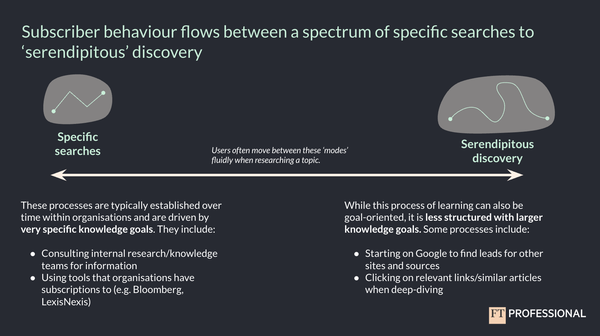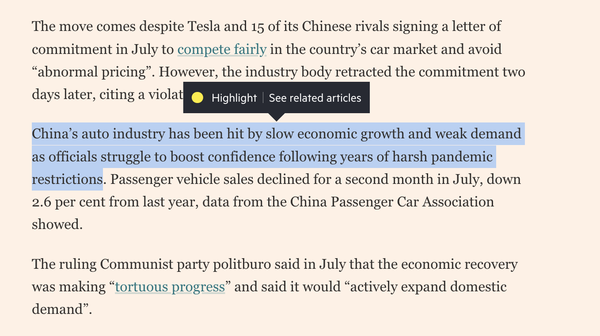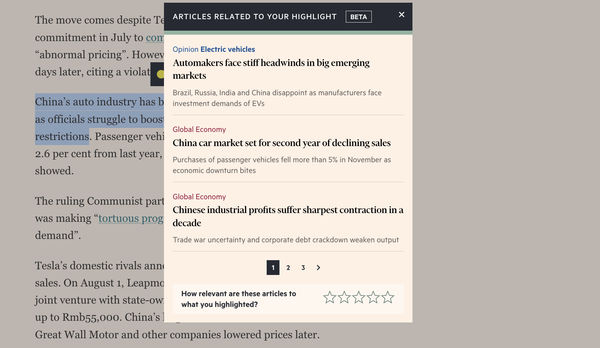How we consume news in a work or education setting is changing, and “being informed” no longer means reading every single article that’s published by the Financial Times or other media outlets.
Those using the FT for work or learning are often time-poor and typically need to understand complex topics and the relationships between news events quickly. A new related articles feature for FT Professional subscribers helps address this by using AI to intelligently select articles based on highlighted selections of text. Subscribers benefit from being able to dig deeper into specific elements of a story by receiving hyper relevant article suggestions, and saving on the need to run supplementary searches.
Using AI to deliver enhanced relevance
FT Professional subscribers across all industry sectors and job functions refer to the challenge of keeping on top of everything they need to know. In a world where the rate of change is fast, the relevance of information is keenly important, but subscribers also don’t want to miss out on anything that could improve their broad understanding of a particular subject matter.
While subscribers do run specific searches on FT.com and some use specialist 3rd party research tools, many tell us that they tend to discover relevant articles serendipitously through related article links.





FT.com article suggestions up to now have relied on ‘tags’ (this article is about Tesla, therefore here are several more articles about Tesla) but this isn’t especially helpful if that tag wasn’t the aspect of the article you were predominantly interested in (if you were actually researching the Chinese automotive sector more generally, for example).
The new related articles feature instead uses AI to return the most semantically relevant articles to a selection of highlighted text (the related articles are selected based on the meaning of the highlighted words rather than by just matching keywords).
Not only does this save subscribers time in terms of limiting the need to scroll through pages of results to find articles of interest, but also mitigates the risk of missing something highly relevant they might not have seen otherwise.
Where are these related articles surfaced on FT.com?
The new related article feature is only available to FT Professional subscribers (those who access FT.com through their organisation or education institution) and appears alongside the option to ‘Highlight’ when a section of text is selected on an FT.com article.





Selecting ‘See related articles’ brings up the related articles pop up of articles that are semantically relevant to the selected text rather than the overall topic of the article.
The pop up will always show the 3 most relevant articles to your selected text (how recently an article was published does impact the relevance).





Selecting an article will then open it in a separate window.
This is the first iteration of this feature and we welcome feedback on its value and the relevance of the suggested articles in order to help guide future development.
Experimenting with AI to solve subscriber pain points
The use of AI in business, and more specifically generative AI that can be used for applications such as writing text or generating realistic images, is a hugely exciting topic, and one that’s become a more important area of coverage for the FT.
It does however also have potentially very serious implications when applied to journalism, particularly at a time where misinformation is widespread and trust in the media is on the decline. Financial Times editor Roula Khalaf recently wrote a letter to subscribers outlining her position on the use of AI in the newsroom.
“FT journalism in the new AI age will continue to be reported and written by humans who are the best in their fields and who are dedicated to reporting on and analysing the world as it is, accurately and fairly,” Khalaf explained. Equally, the FT has long been a leader in digital journalism and “will embrace AI to provide services for readers and clients and sustain our record of effective innovation.”
FT journalism in the new AI age will continue to be reported and written by humans who are the best in their fields and who are dedicated to reporting on and analysing the world as it is, accurately and fairly.
Editor, Financial Times
The goal of FT Professional is to make FT journalism more actionable and useful for business and education audiences, and AI-powered tools have the potential to play a key role in achieving that aim. The related articles feature is one of a number of other experiments currently in development that look to leverage AI to help Professional subscribers identify opportunities and threats more quickly, as well as save time on in-depth research.
Learn more about FT Professional
FT Professional equips users with specialist knowledge and tailored insights from the Financial Times to help them make the best strategic and commercial decisions in an unpredictable global environment. Our customers get more from FT journalism through additional resources, curated news and action-oriented tools.
Help your team make better business decisions with the FT’s trusted commentary and analysis. For more information about how FT Professional can help your organisation, please get in touch.
